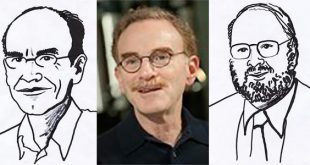A team of researchers from Canada and the United States have unearthed the oldest pachycephalosaur fossil in North America – maybe even the world – and said its existence hints that other dinosaurs may also have had dog-sized versions.
When Roy Audet let researchers scour his ranch for creatures that roamed there roughly 85-million years ago, he didn’t expect them to find the fossil of a dinosaur with features that he’ll jokingly admit they might share – he didn’t expect it to be named after him either.
But, a team of researchers from Canada and the United States did just that when they found a skull cap belonging to a new species of pachycephalosaur on his southern Alberta ranch in 2008.
“I get lots of jokes because I am a bit hard headed you know,” Audet told SciFare.com.
Formally named Acrotholus audeti, it’s the oldest pachycephalosaur dome found in North America – maybe even the world – it’s roughly two inches thick and sat on the head of a dinosaur that’s about as big as a large dog, but stretched roughly six feet long from tip-to-tip.
“It has a very well developed dome for its geological age,” David Evans, study co-author and curator of vertebrate paleontology at the Royal Ontario Museum in Toronto, told SciFare.com. “The vast majority of dome-headed dinosaurs in the fossil record are basically based on isolated skull caps.”
Fortunately for researchers, they found a less complete dome sitting on their shelf after it was recovered from the same region, more than 50 years ago.
“Even though I had recognized it as being something distinct, it wasn’t until Caleb found the really good specimen in 2008 that we really clinched it,” Evans said. “It’s very well preserved, has a lot of detail and shows how a lot of characteristics of pachycephalosaurs that we thought appeared later in the fossil record, actually occurred earlier.
In order to look at the dome’s internal structure, researchers used a CT-scanner and found that by the time the dinosaur started walking into the fossil record, it had already evolved into one complete unit.
“So, the acquisition of a very tall dome had occurred, at least, by the time of Acrotholus, 85 million years ago,” he added.
The CT-scan also allowed them to determine the dinosaur’s life stage without destroying it – traditional methods require them to slice the bone and dye it – and weighing roughly 100 pounds, it was entirely possible that it belonged to a juvenile.
“We can tell by the density how mature the individuals are,” Evans said. “In this case the dome’s extremely dense and that’s something we only see in the most mature adults.”
Turns out their thick skulls actually have profound consequences for the entire fossil record – their unique head gear may be the only reason we know them at all.
By dinosaur standards, Acrotholus is small. The researchers say that if a mature, small bodied pachycephalosaur exists, small bodied versions of other dinosaurs should exist too – but they don’t.
“Their bones are very small and susceptible to weathering and destruction by predators,” Evans said. “Something about the size of a small dog would be one bite for a predator, and all of those bones would be gone.”
So, if they didn’t end up as hors d’oeuvres, their skeletons were certainly ground up by the sands of time – the planet looked a lot different 85 million years ago.
When the researchers added the new find to the pachycephalosaur family tree, they found Acrotholus’ dome was closely related to a pachycephalosaur from Mongolia, known as Prenocephale.
Fortunately, its skeleton is more complete and researchers were able to use it to generate the image of Acrotholus’ – the turtle in the picture was also found on Audet’s ranch and described by a team that included Evans in 2012.
Eric Snively studies how pachycephalosaurs might have used their thick skulls – he wasn’t part of this discovery though. He told SciFare.com the research is interesting because it shows much there’s still left learn about this time period – known technically as the Santonian – and pachycephalosaur evolution during it.
“They would have split off from their sister group, which are horned dinosaurs like Triceratops and their relatives, many millions of years before we find the first good pachycephalosaur fossils,” Snively, who’s currently a post-doctoral researcher at Ohio University, told SciFare.com.
“There are still a lot of gaps to fill in, but we know that by the time this animal was around they were pretty standard looking pachycephalosaurs,” he added.
He’s also intrigued by the idea that many other small-sized dinosaurs are likely waiting to be discovered – if their existence hasn’t been ground out of the fossil record.
“It’s showing us more evidence that there’s greater diversity of small dinosaurs than we thought,” Snively said.
Evans said his team’s gearing up to head back to Audet’s ranch later this spring so they can hunt for more new and cool fossils. For Audet, it’s just another chance to learn something cool about the creatures that once dominated his ranch, 85-million years ago.
“It’s always fun for me when someone comes along from the scientific community because I can always learn something,” Audet said. “It’s not difficult for me to help ‘em across the river with a canoe or let ‘em park in the yard.”
The new dinosaur was described in the journal, Nature Communications.
‘Like’ our page on Facebook and follow @ScienceFare and @LeeFlohr on Twitter.
 Science Fare Media Science News – Upgraded
Science Fare Media Science News – Upgraded





